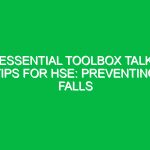Introduction
In the realm of Workplace Safety, the term “slips, trips, and falls” (STFs) looms large as one of the most common causes of injuries. The importance of addressing these Hazards cannot be overstated; they account for a significant percentage of workplace accidents across various industries. A Toolbox Talk focused on slips, trips, and falls is a critical component of health, safety, and Environment (HSE) training. It serves as a platform to educate employees about the risks associated with these incidents and to promote safer workplace practices.
By engaging employees in discussions about slips, trips, and falls, organizations can foster a culture of Safety, ultimately reducing injury rates and enhancing overall productivity. This article will delve into the essential elements of a slips, trips, and falls Toolbox Talk, exploring its relevance within the HSE framework, the risks involved, and practical solutions to mitigate these Hazards.
Understanding Slips, Trips, and Falls
Before diving into the specifics of a Toolbox Talk, it’s essential to understand the definitions of slips, trips, and falls.
- Slips: These occur when there is a loss of traction between a person’s foot and the walking surface, often due to wet or uneven floors.
- Trips: Trips happen when a person’s foot strikes an object or uneven surface, causing them to lose balance. Common trip hazards include loose cables, uneven flooring, or obstacles in walkways.
- Falls: Falls can result from slips or trips but also occur from heights, such as ladders or scaffolding. They can lead to severe injuries, including fractures or concussions.
Recognizing the differences between these terms is vital for effectively addressing them in a workplace setting. Each type of incident requires specific preventive measures and awareness to ensure employee Safety.
The Importance of Toolbox Talks
Toolbox talks are informal safety meetings that focus on specific safety issues. They are typically brief, lasting around 15-20 minutes, and are designed to reinforce the importance of safety practices among employees.
Key Benefits of Toolbox Talks
1. **Increased Awareness:** Regular discussions about slips, trips, and falls heighten employees’ awareness of potential hazards in their environment.
2. **Promoting Safe Practices:** Toolbox talks encourage employees to adopt safe working practices, such as maintaining clean work areas and reporting hazards.
3. **Engagement:** By involving employees in safety conversations, organizations can foster a culture of safety where everyone feels responsible for maintaining a safe workplace.
4. **Reduction in Incidents:** Frequent discussions about workplace hazards lead to a decline in STF incidents, ultimately saving costs related to workers’ compensation and lost productivity.
Components of a Slips, Trips, and Falls Toolbox Talk
When conducting a slips, trips, and falls Toolbox Talk, it’s essential to cover various components to ensure comprehensive understanding and engagement among employees.
1. Identifying Hazards
Begin the talk by discussing common hazards that lead to slips, trips, and falls. Encourage employees to share their experiences and observations about potential risks in their work environment. Some common hazards include:
- Wet or oily floors
- Cluttered walkways
- Loose mats or rugs
- Uneven surfaces
- Poor lighting
By identifying these hazards collectively, employees become more aware and vigilant.
2. Discussing Prevention Strategies
Once hazards are identified, shift the focus to prevention strategies. This discussion should include practical tips that employees can implement in their daily routines:
- Use slip-resistant footwear.
- Keep walkways clear of obstacles.
- Immediately clean up spills and report hazards.
- Ensure proper lighting in all work areas.
- Utilize handrails on stairs and ladders.
Providing actionable steps empowers employees to take ownership of their safety and the safety of those around them.
3. Real-life Examples
Incorporating real-life case studies or incidents can significantly enhance the effectiveness of the toolbox talk. Consider sharing a story about a slip that resulted in a serious injury. For example, a worker at a manufacturing facility slipped on a wet floor, leading to a prolonged recovery period. The incident prompted management to implement stricter cleaning protocols, but the key takeaway is the importance of vigilance and immediate action when hazards are identified.
4. Engaging Employees
Encouraging participation can make the toolbox talk more interactive and memorable. Ask employees to share their strategies for preventing slips, trips, and falls or discuss their experiences with near-miss incidents. This engagement fosters a sense of community and shared responsibility for Workplace Safety.
5. Reviewing Policies and Procedures
Finally, it is crucial to review any relevant safety policies and procedures related to slips, trips, and falls. Make sure employees understand reporting processes for hazards and accidents. Highlight the importance of following established safety protocols to prevent incidents.
Regulations and Standards
In the HSE context, regulations and standards play a vital role in guiding Workplace Safety practices related to slips, trips, and falls. Organizations must adhere to guidelines set by governing bodies such as the Occupational Safety and Health Administration (OSHA) in the United States or the Health and Safety Executive (HSE) in the UK.
osha Standards
OSHA has established Regulations that address walking-working surfaces, which are critical for preventing slips, trips, and falls. Key provisions include:
- Maintaining floors in a clean and dry condition.
- Using slip-resistant surfaces in areas prone to wet conditions.
- Providing adequate lighting and marking potential hazards.
Understanding these regulations not only helps organizations comply with legal requirements but also reinforces a commitment to Workplace Safety.
HSE Guidelines
The HSE provides comprehensive guidelines for managing health and safety risks, including those associated with slips, trips, and falls. The HSE emphasizes the importance of risk assessments, which involve identifying hazards, evaluating risks, and implementing Control Measures. Organizations are encouraged to conduct regular assessments to ensure ongoing safety compliance.
Conclusion
In conclusion, the slips, trips, and falls toolbox talk is a fundamental aspect of Workplace Safety within the HSE domain. By addressing the risks associated with these incidents, organizations can foster a culture of safety, reduce injury rates, and promote overall well-being among employees.
The importance of regular Training sessions, such as toolbox talks, cannot be understated. They serve as an opportunity to reinforce Safe Practices, engage employees, and create a supportive environment where safety is prioritized. As we move forward, it is essential to continue these discussions and implement effective strategies to mitigate the risks associated with slips, trips, and falls. By doing so, we not only comply with regulations but also create a safer, healthier workplace for everyone.


